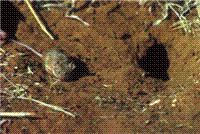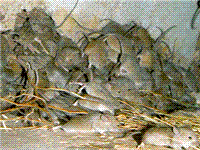Family
Muridae
Genus
Mus
Species
domesticus
Threats/Control Methods - Regional
Plagues of mice cause enormous damage in agricultural regions, causing farmers to loose up to 30 percent of a crop. The safest and most effective control method is to limit the mobility of the pest, causing population stress to wipe the population out naturally. Prevention methods include cutting all grasses around roads, irrigation channels and storage areas to a very short length. Effective monitoring of available ground cover must be ongoing, as mice numbers can quickly and unexpectedly get out of control.
Threats/Control Methods - Local
There is currently no mouse control program in the ACT, as it is not considered enough of a threat. Residents experiencing mouse problems are encouraged to take personal action to control an outbreak.
Local/Urban Actions
To decrease the risk of mice on a private property, residents should ensure all food scraps are covered, including outdoor compost areas. A house can be 'rodent proofed' as a preventative measure, sealing all potential entry points. If mice become a problem, baiting programs using traps and poisons should be used with caution, especially if children and domestic pets may be at risk. Expert pest controllers may be a safer and more effective option.
Common name/s
Mouse, Field Mouse
Distinguishing Features
This species is covered in a yellow-brown to black coloured fur above and light grey to pale yellow fur underneath. The length of the head and body is 6-10cm and the scaly tail is usually 8-9cm. It has bulging, dark round eyes on its small round head and large rounded ears. On close inspection it is distinct due to a notch on its upper front teeth and five pairs of teats on the females.
Similar Species
No other native or introduced species is likely to be seen so obviously within an urban or human modified environment.
Distribution
This species is common across mainland
Country of Origin
Asia
Survey Techniques
Trapping
Conservation (Pet/Pest) Status - National
Common, introduced. About 20 percent of Australia is prone to plagues, especially in the southeast grain-growing regions of Australia.
Conservation (Pet/Pest) Status - Regional
Common
Associated vegetation community
In many parts of the world this species is confined to urban and agricultural regions, however in Australia the House Mouse has also adapted to native forest, woodland and grassland environments. It is even found in desert, tropical and alpine areas. Within an urban environment, they usually inhabit areas where food and moisture is available in drains, under concrete, kitchens, roof voids and garages.
Limiting Resources
This species is extremely adaptable and uses any resources available to food and shelter. Crop harvest, floods, drought, pest control methods, predation and disease will also limit population numbers.
Breeding
In Australia, the breeding season usually runs from October to April, however if the conditions are favourable they can breed throughout the year. They make a nesting burrow and the pregnancy lasts for about 19days, at which time the female may become pregnant again almost immediately. A litter size is usually four to eight young. Young mice are able to reproduce from only two months of age, giving the species an immense reproductive potential.
Behaviour
During the colder winter months they are more of a problem to urban residents, as they take refuge in the warmth and shelter of people's homes. They are highly social animals, living together in small groups. They are curious animals, eating small amounts of any food they can find from various locations. While fairly brave little creatures, they rarely travel more than 10m from their nest. Mice have very poor vision, relying on their keen sense of smell, acute hearing and their whiskers and sense of touch.
Functional Group
Food Species
Cereal and grain crops make up the preferred diet for this species, however fruit and vegetable crops are also eaten. Within urban environments they are oppurtunistic feeders, eating waste products and food scraps of any description.
Predators
Birds of prey are the most likely predator of this species. Foxes (Vulpes vulpes ), feral or domestic Cats (Felis catus ) and Dogs (Canis familiaris) will also kill this species. Humans use a range of physical and chemical methods to deter and kill House Mice.
Interesting Fact
The House Mouse is second only to humans in the extent of its global distribution.
References - (reader suitability of references, P=Primary teachers, S=Secondary students, T=Tertiary students and researchers)
Books:Strahan, R. (ed.) 1995. The Mammals of Australia. Australian Museum Trust/Reed Books. Chatswood NSW. P, S, T
Online Publications:Adelaide Pest Control. 2002. Rodent Control. The Marsupial Society of Australia. [online]. Available at: http://www.marsupialsociety.org/02sp02.html P, S, T
Department of Primary Industries. 2004. House Mice in Victoria. The State of Victoria. [online]. Available at: http://www.dpi.vic.gov.au/dpi/nreninf.nsf/LinkView/C10E7DE30C42DDFECA256BCF000AD59332D5A44079BFAC274A256DEA00295B86 S, T
Tidemann, C., Roscoe, T. and Mitchell, B. 2006. Mammals of the Lower Sullivans Creek Catchment, Canberra ACT. Prepared for the Life in the Suburbs project using data from the Lower Sullivans Creek Catchment Ecological Survey (LSCCES). Australian National University. Canberra. [online]. Available at: http://www.lifeinthesuburbs.com.au/category.php?id=65 S, T
Fumapest Group. 2007. Rats and Mice: Control Methods. Fumapest Group. [online]. Available at: http://www.termite.com/rodent-rat-mice-control.html P, S, T
Researcher: Naomi Hogan


 Top
Top Top
Top